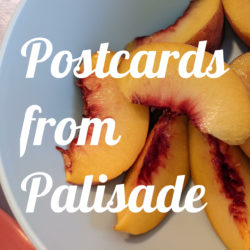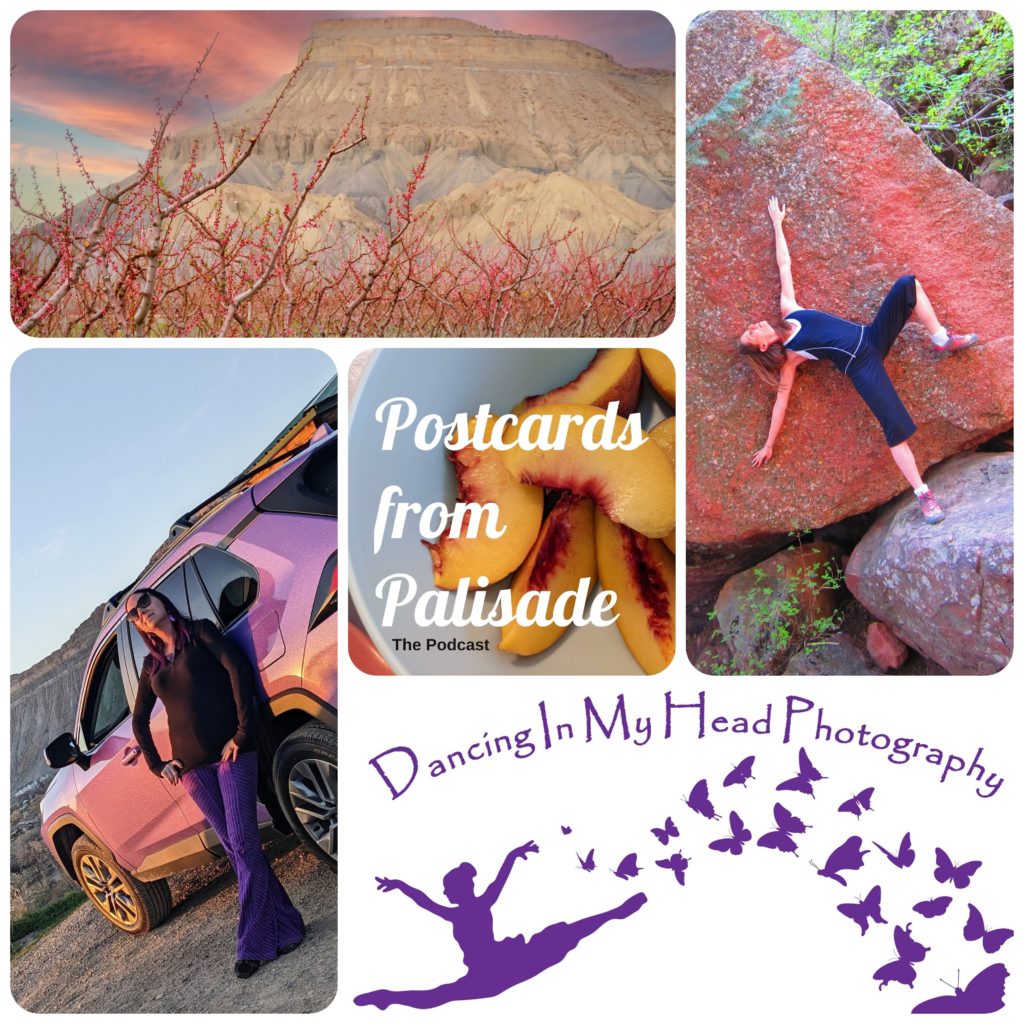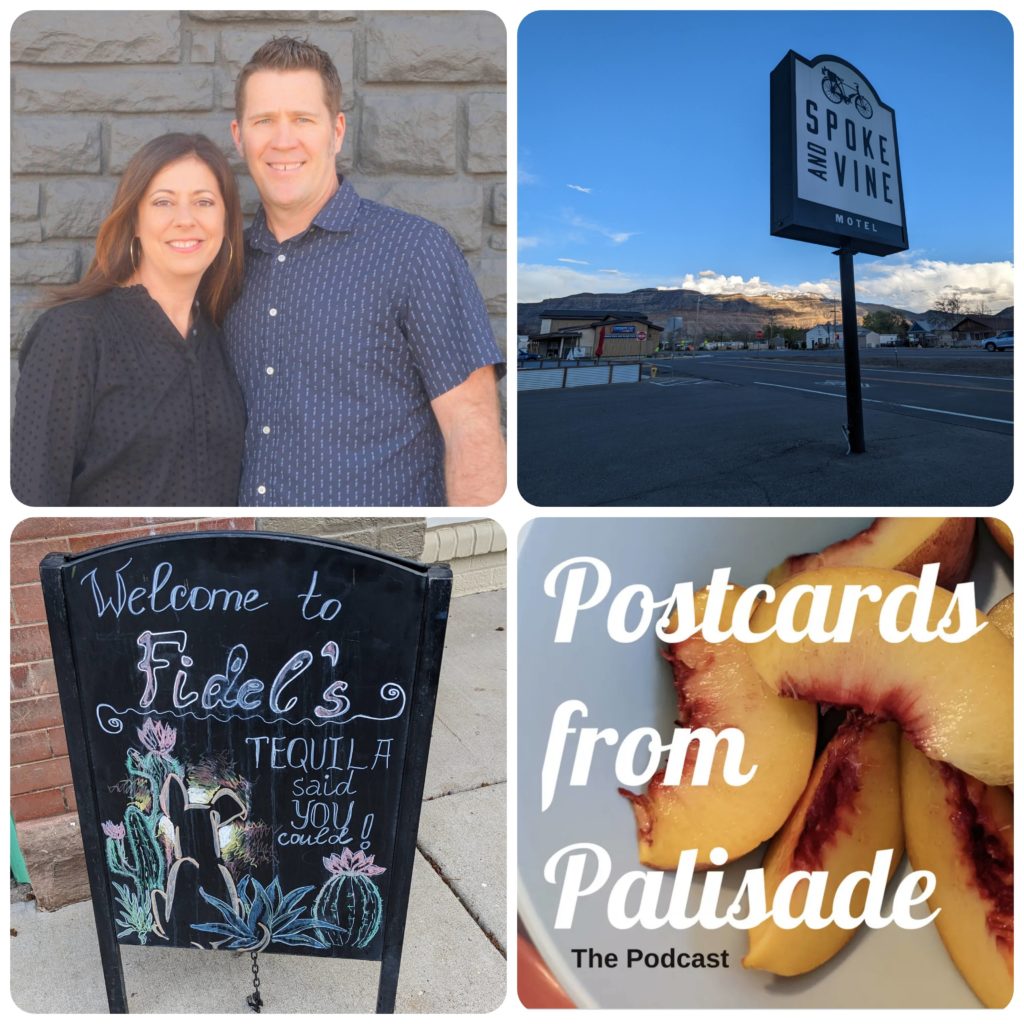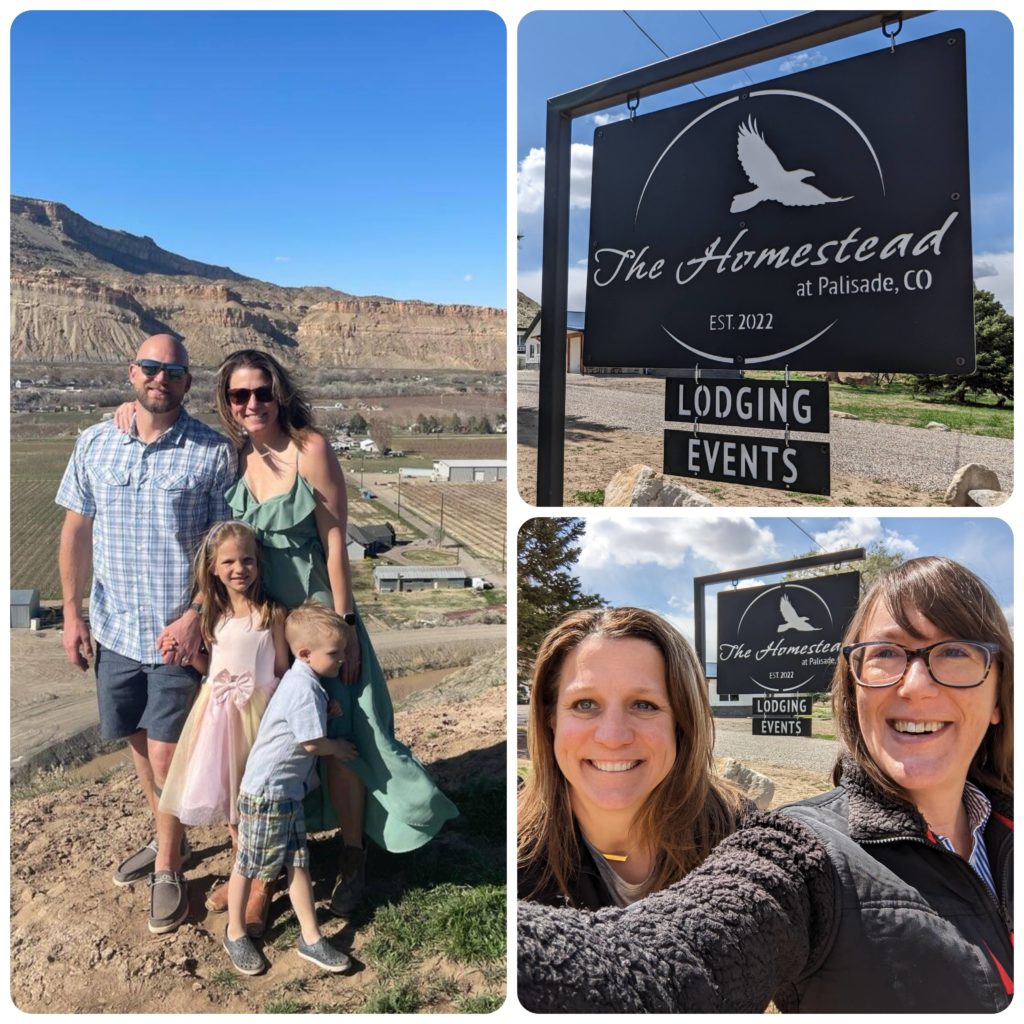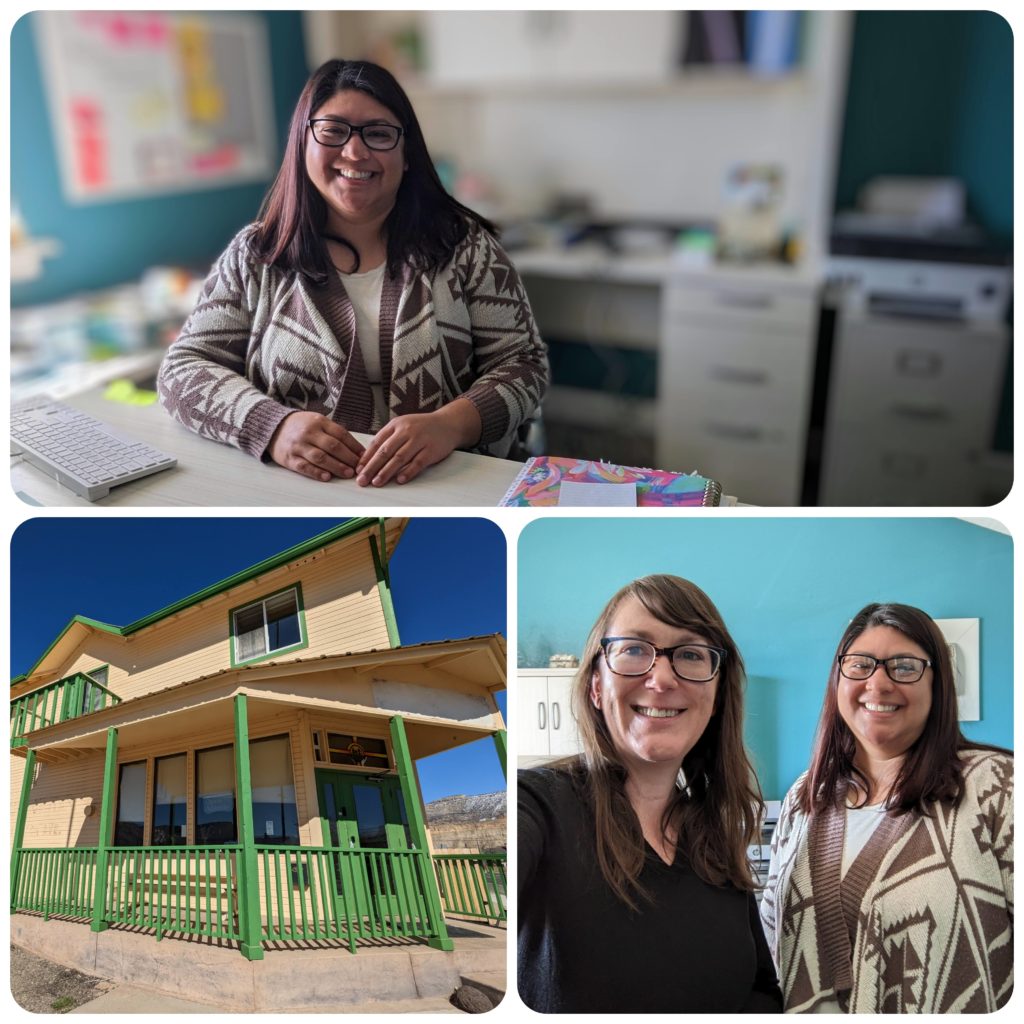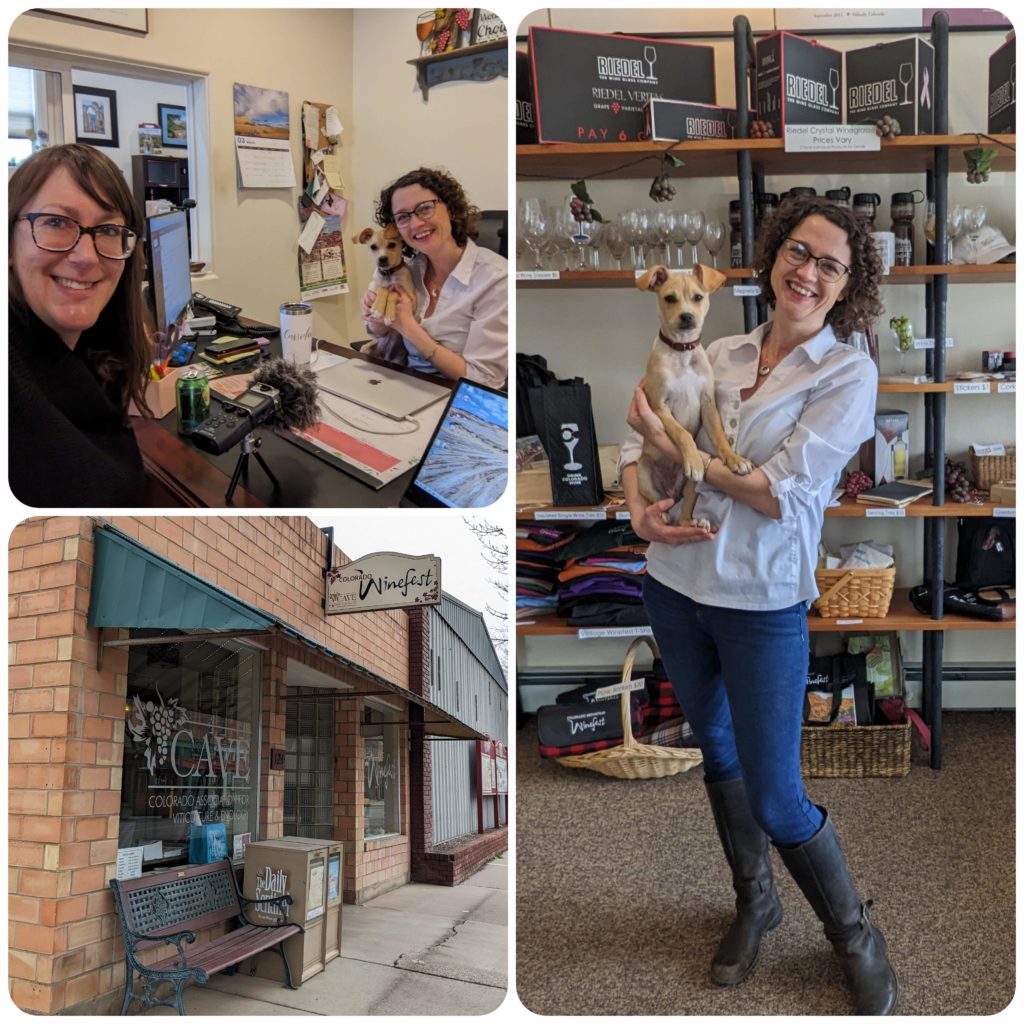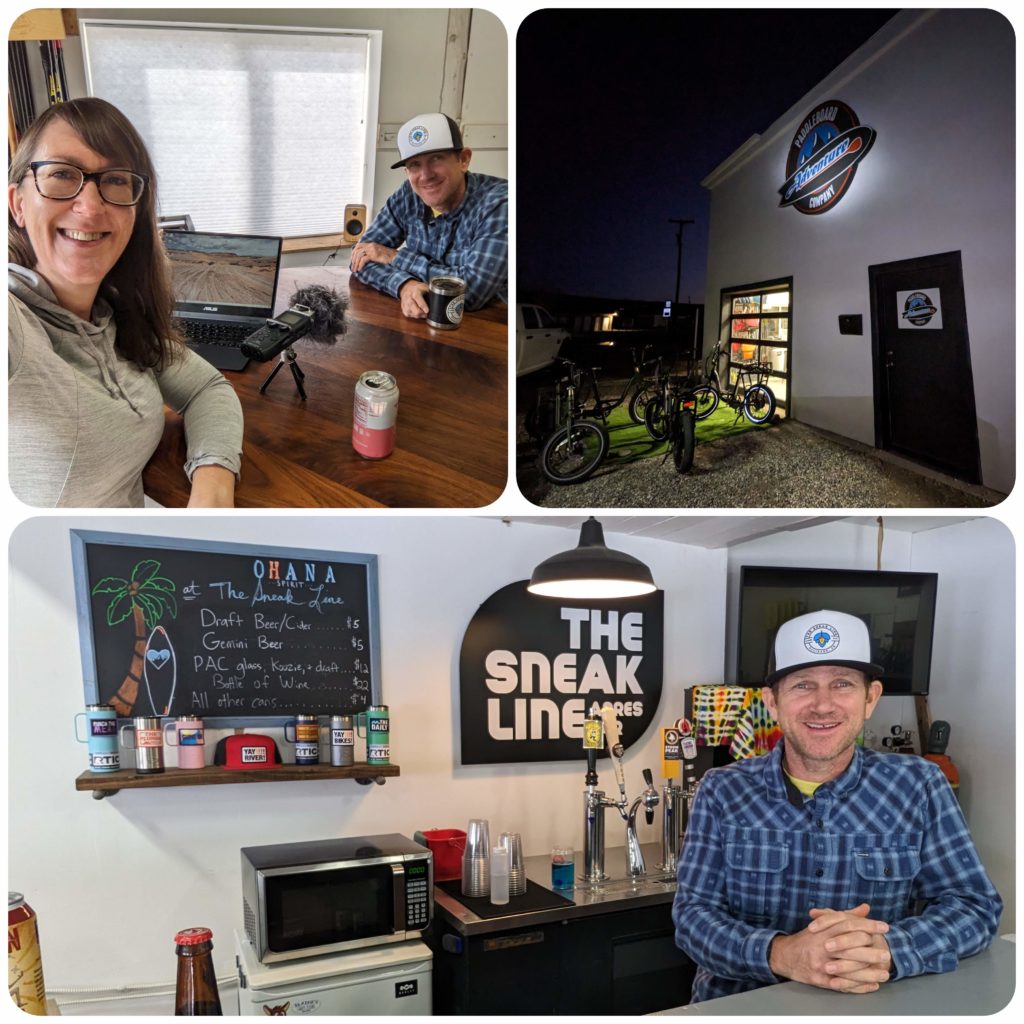Christine Moore is a yoga and dance teacher and yoga therapist based in Palisade. Christine and I chat about the difference between yoga and yoga therapy, the different classes she teaches – both regularly and for special events like the upcoming Grand Valley Yoga Fest, yoga philosophy, the history of belly dancing, what always draws her back to Palisade, how she takes care of herself so she can best take care of others, and lots more.
For more info about Christine and her classes and other offerings, check out her website: christinemooreshimmyogini.com
For more information about the Grand Valley Yoga Fest, check out their website. 100% of the proceeds of the festival go to mental health and suicide awareness programs in the Grand Valley: grandvalleyyogafest.com
Music by Romarecord1973 from Pixabay.
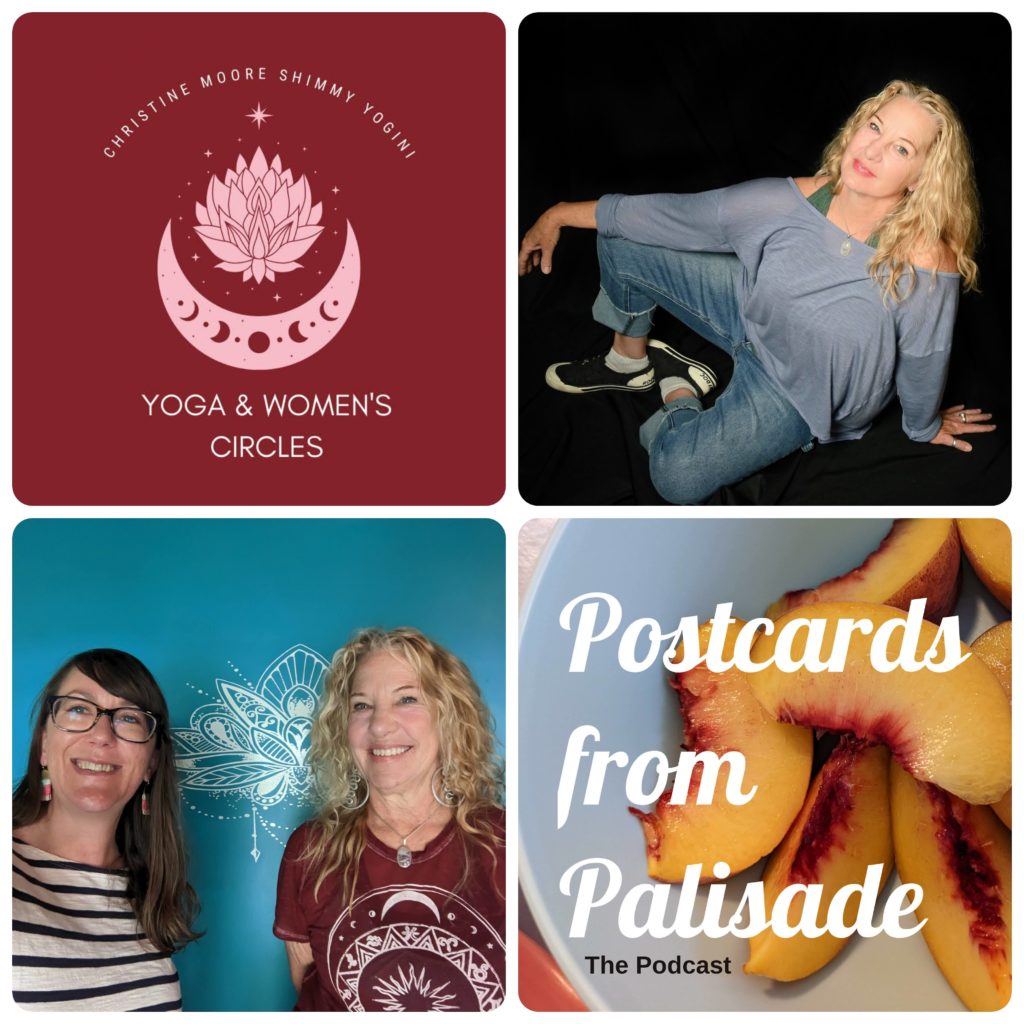
Subscribe:
Transcript:
Hello and welcome to Postcards from Palisade, the podcast that shares a snapshot of the people and places that make this slice of western Colorado wonderful. I’m your host, Lisa McNamara.
Today I’m talking with Christine Moore, yoga and dance teacher and yoga therapist here in Palisade.
Christine and I chat about the difference between yoga and yoga therapy, the different classes she teaches – both regularly and for special events like the upcoming Grand Valley Yoga Fest, yoga philosophy, the history of belly dancing, what always draws her back to Palisade, how she takes care of herself so she can best take care of others, and lots more.
Like why she is drawn to work with the populations she works with:
CM: I was really inspired, and am really inspired, to work with people that are challenged to get to the mat vs. people that can like hop in a car and be there and are super athletic. I like to help people find results, and that’s what really excites me about yoga.
The meaning behind her sword dance:
CM: I like the concept of cutting away that which doesn’t serve. Clearing the space. Making room. So it’s not really a weapon, so much as it’s a, something to transform, to change, and to shift. And it’s fun. For me, I’ve always loved dancing with a sword.
And about what teaching yoga and dance has meant to her:
CM: Oh, I think it’s saved my life, in so many ways. In my own experiences with trauma in my life and a lot of loss, and just a lot of different challenges that life has, it’s really helped motivate me. And I think in helping – I don’t even like the word helping, because I love to bring out what people already have inside. That’s why I feel I do more than helping them. They’re helping me.
All that and more, on today’s Postcard From Palisade.
Christine Moore (CM): I’m Christine Moore and I like to start by just letting people know that I’m a yoga teacher. I’m a dance teacher as well. And a yoga therapist. The difference being that a yoga therapist works more one on one with people and helps them with personal challenges and working with a doctor or with a physical therapist to address specific things that yoga can help with. So it’s a little different than regular yoga class.
Lisa McNamara (LM): Do you need special training or anything for that?
CM: Oh, absolutely. I think there’s only two or three possibly certified yoga therapists in Mesa County. So, there is quite a bit of extensive training, and for me, I had about ten years of working with people with disabilities in group homes and veterans at the VA hospital. I worked for five years at the Boulder County jail. So I had a lot of experience under my belt already with working with different populations. And yes, there’s extensive extra training from yoga certification.
LM: Interesting! So, tell me about your path to yoga – how did you get started?
CM: Oh, gosh. I was teaching dance for several years and I had a dance troupe in Boulder, and I started feeling like I needed more for my dance, so I thought yoga would be an interesting add-on, since I always enjoyed taking yoga classes. So I really started yoga to enhance my dance practice. And then, during the training, my son was serving in Afghanistan and one of my fellow teachers brought me an article about teaching veterans, and I felt like my skin tingled, you know, as I read it. I thought, wow, this is something I’d like to do.
So I looked into it, right after I was certified, and started at the VA hospital in Denver, and that just started the rest. I was really inspired, and am really inspired, to work with people that are challenged to get to the mat vs. people that can like hop in a car and be there and are super athletic. I like to help people find results, and that’s what really excites me about yoga.
LM: I saw that you had a link to an article in the Huffington Post about your work with veterans and with people with disabilities, and it just sounds like such a rewarding group of people to work with.
CM: It’s very rewarding. It’s really lovely to have people come to you and let you know that it’s really changed their life and that in itself is just very fulfilling.
LM: And how did you get to Palisade?
CM: Oh, well, my son moved here several years ago. He graduated from college and said he’d go apply for a job in Grand Junction, just for the experience, and then ended up finding work here and getting hired. And so, once he and his partner at the time decided to have a child, they invited me. Five years ago. I moved here two weeks before she was born, and I came for that. The invitation came and it just felt like the right time. I felt like Boulder was outgrowing me. It’s really changed, and I had been there for fifty years. So it was a lot to let go of, but I’m really happy with making that decision.
LM: Yeah, that’s tough though, to let that go and to move to somewhere totally new.
CM: It is tough, and yet I can hop in the car and be there in four and a half hours.
LM: Yeah, good point!
CM: And I have plenty of places to go stay and visit and people to see. I really miss the people. When I go over there now, it changes so rapidly that I kind of feel like, I can’t wait to get back home! Which surprises me. Because I do, I love the front range, I love Boulder, but it has really changed a lot, and a lot of those changes break my heart. So. I like the small town, small community.
LM: Where and what do you teach here in Palisade?
CM: In Palisade I teach at the community center, I call it, the Veterans’ Memorial building, and we move outside in the – probably next week, we’ll start yoga in the park, right over here at Peachbowl Park. And I also offer some privates at my home studio, so I like working one on one with people to really help them enhance their yoga practice or benefit from learning more about what they can do for themselves to improve their health.
LM: For the classes here in town that anybody can sign up for and take, who do you want to welcome into those kind of classes?
CM: I really like to look for people that want something a little different than a regular studio has to offer. Maybe they’re a little intimidated by that, or they might be working on a personal injury. So a lot of my students are a little older, and some are coming from a background of just having an injury or not really feeling like they fit into a regular studio class. So I can offer them like a safe space.
I offer different, I don’t like to call them levels, but more so options for people, so if some people want to really push themselves a little more, they can, and other people can find a way to feel safe in their body. So I’m always watching for what it is that the people that I’m teaching need, rather than a lot of the yoga classes I’ve been to, the teacher just teaches the class, and I try to teach the individual students that I have in front of me.
LM: That’s awesome. Those birds are going crazy! I love it.
CM: They are!
LM: There must be a little nest or something over there. But that just seems like something that is really missing from a lot of areas or studios or things like that.
CM: It is, and yet I don’t think people know what it is they’re wishing for, so that’s the tricky part. To try to help people understand what I offer. I am really a fan of yoga philosophy too, because I think it really ties into better health and it suits a lot of people and a lot of people are a little shy about that too. They don’t know what it is. And it’s something that’s applicable to pretty much any lifestyle or belief system.
LM: And it can be really intimidating, because I know it’s like, if you feel like, well, you don’t know the moves or you don’t want to embarrass yourself, like, it can be intimidating, so it’s nice to have just more of an open and welcoming environment.
CM: Yes.
LM: Do you base your practice on any specific – and I’m not going to get the right terminology, but, style of yoga, or teaching…
CM: Yes and no. I really would say my classes are trauma-informed, so I’m very aware of what people might be triggered by, different populations, and the yoga therapy. So it’s Hatha yoga, which is pretty common, and I have learned a lot from Iyengar teachers and different practices. I teach yoga Nidra, which is yoga for sleep, it’s meditation. So I like to do a little guided meditation at the end of class to reset people. I really try to find a structure where people have the opportunity to get a little movement going and then calm themselves back down. Sometimes emotions come up in yoga and we don’t know what to do about it, and what I love about the practice is it’s really designed to calm the nervous system back down and regulate people so they have that ability rather than just walking out the door like you might if you get a massage, for instance, and something comes up and you’re feeling strange then you’re just kind of left to yourself, so I like that idea that it gives us a way to reset and kind of re-calibrate to be able to carry on with your day.
LM: There’s the upcoming Grand Valley Yoga Festival, I’ve noticed, that’s in a few weeks?
CM: Yes, it’s June 2nd to 4th, yes.
LM: OK. So how are you involved with that? Are you attending or teaching or both?
CM: I’m teaching dance, so it’s going to be a little different. They wanted a dance element. I have a friend that’s teaching some of the sound that’s going to be staying here while he’s here from Boulder and I am participating by leading dance. It will have a bit of a yoga element to it, because it’s a yoga festival, but I want to offer people a way to just get moving, to feel comfortable in their bodies, and express themselves, and just have some fun with it.
LM: Um, this is a totally random question but the sort of thing that I would worry about if I had never come to a class for yoga or for dance or whatever, would be, like what should I wear, you know? What should they wear if they’ve never come to a class before?
CM: Yeah, absolutely, good question. I think anything that feels comfortable to move in. Funny, when I was teaching veterans, I had a really hard time getting those guys not to come to class in jeans, which is kind of cumbersome, or can be inhibiting to your movement. So, maybe it’s all they have. You know, so you don’t want to be too picky about it. Definitely want to be open to people having it accessible.
I mean, accessibility is key. I know there’s a lot of specific yoga clothes out there, but really, you just need to be in something you can move your body in. And then thinking about temperature, if you’re outside especially. Do I want to bring a little jacket, just in case? Or, layering is always good. But something stretchy and movable. You don’t have to have fancy yoga clothes.
And we practice barefoot, so there’s no shoes involved, it’s pretty basic. I have props for people if they don’t have them, we have some at the community center, and for outdoor yoga, if people let me know I can bring things if they need them. So, if they don’t have a mat I can bring an extra mat with me.
LM: That’s awesome. So you mentioned though that you got into yoga because you wanted to improve your dance. So what kind of dance do you do, and do you still dance?
CM: I do, kind of! I gave up my troupe. I’m actually a belly dancer, so I studied belly dance for several years and I taught and had a troupe for 25 years on the front range. I was a little bit ready to let it go when I moved over here, and yet, once in awhile, I really miss it. I miss it a lot. What I miss about it the most I think is the way it can really enhance people’s lives and help them feel better about the body that they’re in. So I’m more interested in movement elements that enrich people’s lives and their feeling about themselves now than I am about stage presentation.
LM: Interesting difference.
CM: I do the Sing Up The Sun performance, and preferably I would have enough time to set it on the dancers and have them perform, not necessarily perform myself. I love performing, I’ve performed for years. I performed professionally, but I – I’m just not – I mean, I’m 63, and it’s not something that inspires me as much as, especially with women, having women really get comfortable in their skin, because that’s challenging in this culture. In many cultures.
LM: Yeah, absolutely. You mentioned the Sing Up The Sun festival, and I did see your performance there, along with the others, and it was so cool! So, I have to ask about the sword portion of the dance. What’s the significance of that?
CM: Well, the funny thing about belly dance, which is why I kind of like to fuse it with other dance forms, is that there’s so much of the history that’s missing, so it depends who you ask! For me, being a yoga person who is really interested in Hindi philosophy and deities, I like the concept of cutting away that which doesn’t serve. Clearing the space. Making room. So it’s not really a weapon, so much as it’s a, something to transform, to change, and to shift. And it’s fun. For me, I’ve always loved dancing with a sword. I love the props. But yes, as far as historically, it’s kind of hard to piece it together. You know, where did swords come in? They really came in when belly dancing moved more to the United States. They’re not something that’s maybe as indigenous to the culture. So, that’s true with several things. It’s changed so much over time.
LM: It’s super impressive to see. It’s like, everybody’s just sort of gasping, you know? Like, ah!
CM: I know. My little granddaughter – my son and his fiancee didn’t know that I was performing sword and they said, oh, she’s got her sword. And my granddaughter says, oh yeah, she does that. Because she dances with me over here and I’ll get the sword out because it’s kind of fun, she’s like, in awe. And, oh yeah, she does that!
LM: I have to ask a dumb question though – have you ever cut yourself with the sword?
CM: I cut someone else.
LM: Oh no!
CM: When I was performing. I’ve hit myself in the head with the little hilt, but, we were doing this piece and I was moving through space, and we were pretty close together, and I cut one of my dancer’s hands. And she kept going through the whole performance in spite of it and I didn’t even know. It was, and we still talk about it. It’s one of those things you don’t forget. I just hit her with the tip of the sword and cut her hand. So she was doing the dance and bleeding.
LM: Oh gosh!
CM: So, yeah. Little hazardous.
LM: Right, I had to ask that, because you have it, like, in your teeth and it’s like, ahh oh my gosh! It’s really cool though, the performance is really cool.
CM: I actually balance it on my chin. It looks like it’s in my mouth but I’m balancing it on the chin.
LM: Ah, it does! OK! Cool. How has teaching yoga and dance to others, how has that impacted your life?
CM: Oh, I think it’s saved my life, in so many ways. In my own experiences with trauma in my life and a lot of loss, and just a lot of different challenges that life has, it’s really helped motivate me. And I think in helping – I don’t even like the word helping, because I love to bring out what people already have inside. That’s why I feel I do more than helping them. They’re helping me. Because, for instance, teaching veterans was such a huge inspiration and really helped me face some of the challenges and learn more about challenges I might have when my son returned home from his tours. So I really feel it’s a gift to myself to bring yoga and dance to other people.
LM: When you do the therapy and working with others through yoga therapy, how do you let go of that trauma that other people kind of bring to you? Because I think personally, I would personally be terrible at that because I really hold on to the things, and you know, I wouldn’t know how to let it go. So how do you make sure it doesn’t weigh on you?
CM: That’s a great question, and it’s a constant challenge, you know, because I really try to draw my strength from source, so to speak, because I don’t really feel like a lot of my work comes from me – it comes through me. So, if I can really vitalize myself to begin with. Not take on too many clients. And sometimes it’s a little unavoidable. I do some grief circles online, I do women’s circles online, and quarterly they are grief circles, and I can leave circles sometimes just feeling shot for the day. I’m really wiped out.
So I have to remind myself to really build myself up and to not take things on. And it’s a constant challenge. That’s a really good question. I think that really maintaining a good diet and good health is useful. And once in awhile, it just sticks. It’s a little unavoidable. But for the most part, over time, I’ve gotten better and better at not absorbing what other people are feeling, because it’s not mine to have, you know? But it’s a challenge.
LM: I bet. I bet. When I was reading about your yoga therapy, or anyone who does any kind of therapy or grief counseling, or anything like that, I think that would be really challenging to make sure that you can be there for somebody and support them through what they’re going through, but also take care of yourself, so can help other people.
CM: Yeah, it is definitely a consideration. Different people take on more than other people, and I think it’s been really good for me to learn that too, because I can easily take on too much with my family. And so, how do we stay in our own lane? Yeah.
LM: Good thing to be aware of. But hard. Hard to keep that in mind.
CM: It is. It really is.
LM: So do you consider what you do to be a business you run or do you consider it something else?
CM: I consider it more of a business now. I work for the Giveback Yoga Foundation, too, and so I actually help distribute mats to a lot of under-served communities all over the country. So that ties in to my passion with yoga. And, yeah, I do try to keep it in a business scope. I teach at the Grand Valley Oncology, so I work with cancer patients there. And I do consider it a business, although not – I’m really not able to sustain myself with just that. So it is a constant challenge. I have to bring in other things to bring up my income level.
And there are so many people that offer yoga as more of a hobby and maybe for free. It’s really expensive to keep all my certification up and to continue with my training. So, that is something to consider too. In the work I do.
LM: Yeah, that’s interesting. The hobby vs. work distinction is pretty important.
CM: It is. And in a rural community, frankly, it’s a little less noticed when people have specific qualifications vs. in a place like coming from Boulder where it’s really expected. It’s just a different type of expectation, I think, from a teacher there than it is here.
LM: So, switching over to Palisade stuff, so you’ve been here, five years, you said?
CM: Yes.
LM: So, what’s your favorite part about the Palisade community?
CM: I love being in a small community. For instance, when I had covid, I had little gifts of food left at my door. I know all my neighbors. I feel this real welcoming presence in all of that that’s so different. I lived in a townhouse in Boulder, the last one I lived in, for 20 years and I didn’t know my neighbors the way I know them here. I like how accessible it is to hiking and different – you know, it’s just beautiful to be out in nature here. And so I love that about Palisade. And I feel like it keeps growing and changing, and it’s just fun to be in a small town.
LM: I know, the train. The train is in every episode. It’s unavoidable.
CM: It’s so loud for a couple seconds there. Then it kind of…
LM: I know. Do you sleep through it? Have you gotten used to it?
CM: I do. I think that, once in awhile, it might wake me up without me knowing that’s what it is, but I think for the most part I’m used to the sound. I mean really, if you live in Palisade, you hear a train.
LM: Yeah, you have to get used to it. I’m like surprised that I got used to it, because I’m a really light sleeper, and I do think that sometimes it does wake me up and I don’t realize it, but, for the most part, I don’t know how that happened!
CM: I know, it’s, and I forget sometimes to tell people, if they’re coming here to stay with me, like oh there is a train. And they’re like, well how loud is it? And it’s hard to gauge because we’re used to it.
LM: Yeah, anyway. But yeah, getting to know your neighbors – it is so different, because I do feel like people look at everybody here as a friend, as opposed to, even in Fort Collins, I knew who my neighbors were but you would sort of say hi quickly in passing, not really make eye contact, and just – it’s a totally different feeling.
CM: It is, and when I moved here, people were saying, you’ll get to know everybody in town. And I though, well, probably not, you know! And yet, in some ways, you do. And I certainly know most of the people in the neighborhood, and even a couple of blocks over. People I walk my dog with. Which is a really different feeling of community and connection that I didn’t have in Boulder. I would have to seek that more and here it’s kind of a natural.
LM: Completely. Do you have regulars who come back to your classes every – is it every week?
CM: It’s every week. Right now I’m teaching once a week. I might add on. Last summer I added because people really like to be outside. So I do, I have people that have been very consistent and some who kind of wiggle in and out. They’re here maybe once a month, or traveling different – you know, Palisade is that kind of a community where people travel a lot, come and go. There’s seasons that people are too busy here.
LM: Yeah, makes sense.
CM: It’s a really different season here that I don’t think people quite understand and that has taken me awhile to grasp. As far as when people are really available or not. It’s different here.
LM: Yeah, it’s interesting to get used to. I wasn’t expecting it to be so quiet over the winter, but I think after being here for a few years, we might come to appreciate that!
CM: Yeah, it is different, and it seems like – the first year I moved here, I took care of my granddaughter for the first year, pretty much full-time, while they worked. And then I surrendered her to daycare and started diving into my practice. Then covid hit. So it’s really been interesting to navigate through all that and set a course for myself that makes sense. Kind of coming out of that being really internal time.
LM: Right, right. Did you do teaching by Zoom or anything during that time?
CM: I did, and I still do. I was teaching Thursday nights at the community center and that shifted to online and it stayed online, partially because they ended up giving the space to someone else during that time slot and also because I can have, for instance, my mom, who is 92, comes to my Zoom class every week pretty much and my sister who’s in New Mexico, and some of my friends from the front range or students pop in. So it’s really expanded my practice, and I never thought I’d be comfortable teaching yoga online and I really like it. So, that changed.
LM: Do you do the moves along with everyone, or are you more observing and directing, or, not directing, guiding, I should say?
CM: I, yeah, it’s, that was tricky to navigate and I think one of the things I was resistant about. If I do a one on one with somebody, I’m really navigating them and going back and forth, but my class I’m pretty much demonstrating and know the students well enough, hopefully, that are participating that I can kind of give them cues and different ideas. But a lot of people, especially people with trauma, really need to watch while they do. It can be a little different than being guided if you really know what you’re doing in yoga. And I learned that especially with veterans. Veterans really need to be demonstrated to. And that’s a very generalized statement, but they need to have the visual as well as speaking. So I definitely am demonstrating the whole time online.
LM: Interesting. And that’s cool that it’s worked well and become its own thing now, post-covid.
CM: It has. It surprised me and I’m really happy to be open to it. I’m happy that other people have been. Some people aren’t – some people do not want to practice or participate online and other people prefer it. So. It’s nice to be able to be at home after your practice, especially at night. When I offer yoga Nidra sessions, which are meditation, it’s really nice to be able to leave people in their space and just let them be comfortable. They don’t have to get in a car and drive somewhere.
LM: Right, right, because the whole point is being relaxed and ready for sleeping. You don’t want to get in the car and then drive home and then be all stressed out!
CM: Right.
LM: Yeah, that makes a lot of sense. It’s cool to have the different options to be able to offer. So when you get time off, what do you like to do?
CM: I like to travel. I love to go on river trips. My son’s a real river rat, and so I like to go with them. I like to spend time with my granddaughter, and I like to go over to Boulder and visit my friends there. I like to go to New Mexico and I love soaking in hot springs. But I work so many different places that it’s really challenging to get a chunk of time off. So I’m often more of a three or four day type of traveler.
LM: How do you keep track of all the scheduling of everything?
CM: I wake up in the morning and go, which day is this?! What am I doing today? It’s challenging. I have a Google calendar that I use. That’s really been important and yet each day of the week I might have specific things I do on that day and so I get kind of into my own routine with it. But it can be kind of strange, especially when I do extra workshops and things like that, just to keep it all scheduled and keep it straight.
LM: Yeah, it’s a lot!
CM: But it doesn’t get boring!
LM: Yeah I really rely on the Google calendar too, the reminders and everything.
CM: Yeah, if you’re going to different places each day and you don’t want to be thinking about it overnight or anything, just put it on the calendar and know that you can check it out if you don’t remember or have something unusual going on.
LM: So anything else about, that you want share about anything?
CM: Well I really do love my goddess circle offerings online and those are really fun to dive into some of the history and mythos, so to speak. And to notice how much it can apply to life now and doing a little dancing and writing and those, I would love to at some point maybe offer some small groups in Palisade. But I find that it’s easier to get enough people interested if I keep it online, because people can come from all over the place. And they’re small. They’re intimate. There’s a sense of confidentiality, so that people feel like they can come in and really share and participate without feeling that anything that comes up goes anywhere else. So that’s just something that really, I do them once a month, that I’m really fired up about. They always are really exciting. I do a lot of research and continuing education for those.
LM: You mentioned a lot of the things are still relevant today. Can you just give one example of something that recently surprised you?
CM: Well, I find it really fascinating that in the Hindi mythology, there’s a lot of reference to times like this, meaning times of natural discourse, so to speak, and how that relates to, for instance, how we treat the earth, which in mythology is going to be how we treat that goddess, for instance. And so we find that, in not taking care of the water and the source and the earth, so to speak the earth, but the air we breathe, that there’s repercussions, and that’s definitely part of the mythology. As well as different issues that women have throughout time are really resonant in different deities and what they offer and the support they give to just multiple, almost anything. There’s so many of them. It’s really fun and very fascinating to me. But it seems like whatever I pick seems to be really relevant for people in that time and place. You know, there’s very nurturing deities and there’s some that are really strong and like warriors. And the battle of the warriors is really about the battle of the human consciousness. Like we’re taking the swords and we’re taking the fighting and what we’re really fighting is ourselves. It’s very internal. And that doesn’t go away. That’s sustainable throughout time, that we have challenges and things to work through in life that are part of what life is about.
LM: That’s really interesting. Human nature.
CM: Yes!
LM: Well, I really appreciate your time. And so can you talk a little bit about the specifics of the class that you’re leading for the Grand Valley Yoga Fest?
CM: Well you can go to grandvalleyyogafest.com and it’s a very reasonably priced festival that has a lot to offer. A lot of different things. There’s music, there’s the dance, and my specific class is at 1:15 on Saturday, June 3rd, and it’s all held at the Palisade High School. So you can sign up for the entire weekend and sign up for specific classes. And there’s a lot. And other than that, what is my class called? I’m not even sure! I’ve just been calling it Dance with Christine.
LM: That might be what I’ve seen on Facebook too.
CM: Yes, yes. And the class itself, we’re going to go through some movement, some postures, and some basic movement. I’m always really careful about describing what we’re doing, culturally, because I’m teaching this philosophy and movement and dance, so to speak, from the Middle East, which has nothing to do with yoga, which is from a different area entirely and a different culture. And yet, so much of it goes hand in hand really nicely. So we’ll be doing some isolations. I’ll get the veils out, because they’re really fun to play with. It’s really easy to feel like dance is accessible when you have a veil as a dance partner and don’t have to think so much about your hands. And really I want to get people into how they feel, more than how they look, which is such an important part of movement to me. To really take that subtle movement and energy and enjoy ourselves. So that’s what we’re going to be doing, is just having some fun.
LM: And then regularly, normal classes and things like that, what’s the best way for people to see what you offer?
CM: The best way to see what I’m offering is either to go to Facebook or to my website which is kind of a long name, but it’s christinemooreshimmyogini.com. But even if you looked up Christine Moore in Palisade it would come up. And there’s so much on my website that people can probably find something that’s interesting to them if they’re at all drawn to yoga and dance. There’s just a lot there. And then there’s a contact page on the website so people can contact me that way. Can find me on Facebook too, with my name or just poking around, because I do try to put most of my offerings, at least the local ones, on the Palisade Business Board. I keep my classes listed regularly, and some of my workshops as well, but some of that, if it’s not here, I don’t feel like I want to spill over to that. We also have a Palisade Yoga and Dance Facebook page that the teachers that teach in town post in and I post in. So that’s another resource for people if they want an update. And it’s just called that: Yoga and Dance in Palisade.
LM: That’s one I don’t know about! Cool. Well, thank you so much for your time, I really appreciate. And I appreciate you reaching out awhile ago and just being interested in doing this.
CM: Yeah, thank you. I appreciate that you’re doing this and bringing more of what’s going on here to people. We don’t always know what’s happening in Palisade.
LM: I know, I know, and like I want to know! Thanks, I really appreciate it, Christine.
LM: A few days after I spoke with Christine, after a couple glasses of wine, I was thinking about how I haven’t danced for ages. Something about feeling older, stiffer, worrying more about how I looked than I felt. That distinction really struck me. So I put on my headphones, silent-disco-style, and danced around my kitchen like a maniac. It felt awesome. But I really hope that no one saw me. Thanks for the inspiration, Christine.
If you’re enjoying this podcast, let me know by leaving a rating or review on Apple Podcasts or a follow or rating on Spotify.
If you are interested in being on the show or if you have ideas for a future show, I’d love to hear from you. You can reach me at lisa(at)postcardsfrompalisade.com.
The Postcards from Palisade podcast is available on all major podcast distribution platforms. Find us and subscribe now so you never miss an episode. Latest episodes and links to more information are also posted on the website postcardsfrompalisade.com.
Thanks for listening. With love, from Palisade.

